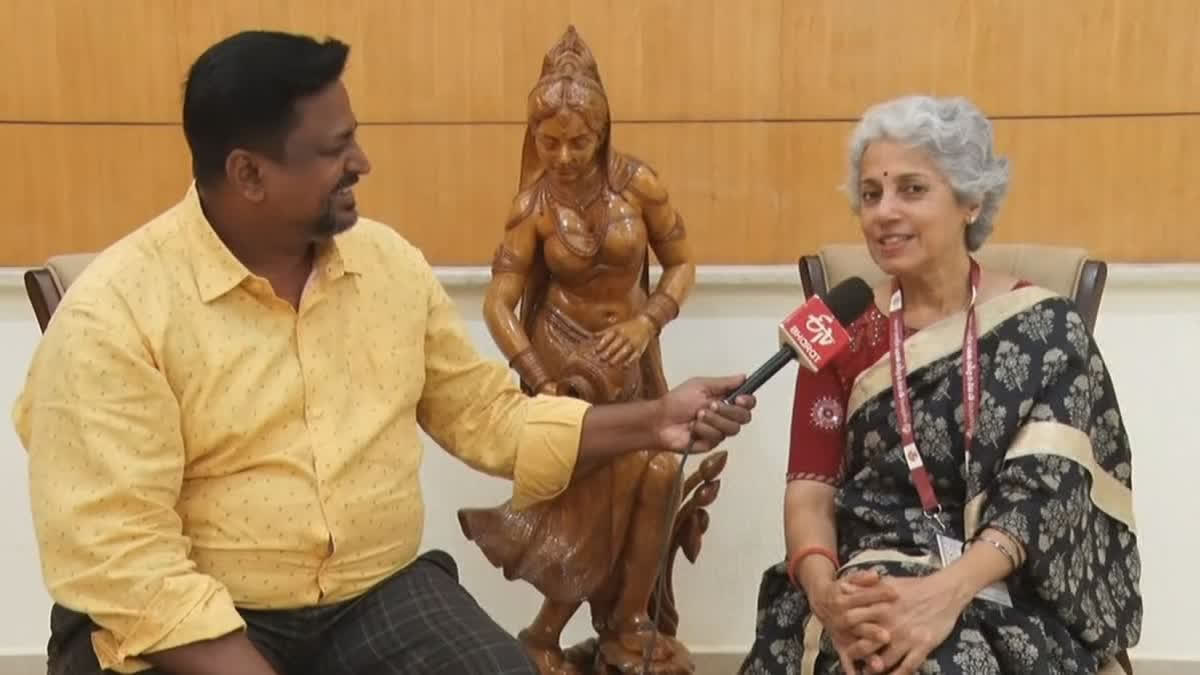Bhubaneswar: Dr Soumya Swaminathan, renowned scientist and global health leader, was in Bhubaneswar, Odisha to participate in the state government’s Millets Day programme - Mandia Diwas observed on November 10. The programme included a two-day Sri Anna Abhiyan and Forgotten Foods Conference that kicked off on Sunday.
Speaking to ETV Bharat on the sidelines of the conference, Dr Swaminathan shared insights into India’s evolving dietary situation, the health implications of limited crop diversity, and the critical role millets can play in addressing nutritional and environmental challenges.
Here are the excerpts from the interview:
ETB: You know Odisha's dietary habits and how these have evolved over the years. How could millets address nutritional and climate-related challenges?
Dr Swaminathan: If we look back at traditional Indian diets, they included a rich variety of foods, which provided balanced nutrition. Over the years, however, a few staple crops like rice, wheat, and maize have come to dominate. These crops gained market share due to high-yielding varieties and government support. This shift in dietary consumption led to reduced diversity, which in turn has contributed to a range of health issues, including obesity, diabetes, undernutrition, anaemia, and deficiencies in iron, calcium, and essential vitamins. Food security has been achieved, but nutritional security is still lacking, as many people remain deficient in micronutrients and proteins.
Millets are very suitable for India as they need less water and fertilizer than rice, making them more sustainable in a water-scarce future. Nutritionally, millets are rich in fibre, protein, iron, calcium, and other essential micronutrients that can help tackle nutritional deficiencies. While we don’t need to abandon rice, it’s crucial to diversify our diets by incorporating nutrient-dense foods like millets, which support both health and environmental sustainability.
ETB: Could you share the specific health benefits of ragi, especially in a state like Odisha? Does it help in curbing malnutrition?
Dr Swaminathan: Rice is high in carbohydrates, while ragi offers a better nutritional profile, containing 7-9% protein. Additionally, polished rice loses its minerals and vitamins during processing, whereas ragi retains a wealth of nutrients, including iron, calcium, and zinc. These are essential for haemoglobin production and immunity.
Odisha’s carbohydrate-heavy diet would benefit from a balance of fresh fruits, vegetables, animal proteins, and healthy fats. Processed food consumption is also on the rise, with households now spending about 10% of their income on it, which isn’t conducive to a healthy lifestyle. At this juncture, including millets in the diet would be a boon.
ETB: Is it feasible to substitute millets like ragi for rice as a staple?
Dr Swaminathan: Yes, millets can serve as valuable alternatives to rice. At this conference, ragi was served in almost all the dishes including curries and kheer and many traditional recipes. Millets, including ragi, are gluten-free, have high fibre, calcium, iron, and zinc, and are great for gut health. They can be cultivated in areas where rice may not grow. However, processing is essential—if we keep the outer coat intact and consume it alongside other foods, it maximizes its nutritional benefits. Some millets may have anti-nutritional factors, but proper processing and combining with other foods make them beneficial parts of the diet.
ETB: How far has Odisha gained significance in its millet mission?
Dr Swaminathan: Certain regions in India, like Kuttanad in Kerala and Koraput in Odisha, have been globally recognized for their agricultural heritage and biodiversity, especially in rice and millet varieties. Even Kashmir is globally recognised for saffron. The Odisha government is now serious about restoring, preserving and encouraging the cultivation of millets, and many other nutrition-rich foods like fruits, legumes, vegetables, tubers which can make the diet of people in Odisha diversely nutritious. The government is actively working to promote millet cultivation and preserve other traditional foods, which can make Odisha an exemplary model for dietary diversity and agricultural sustainability.
ETB: Where do you see Odisha today in agriculture?
Dr Swaminathan: I can see a lot of progress in Odisha is making significant progress. For instance, we are doing a comprehensive rice fallow management program that encourages the growth of pulses and oilseeds, which rejuvenates the soil and boosts farmers’ incomes. Kitchen or nutrition gardens are expanding, particularly in Koraput, where people are growing green leafy vegetables and adding animal protein sources to their diets, which help reduce malnutrition. This integrated approach is transforming nutrition and farming practices across all 30 districts.
I would also urge the Chief Minister to start a school of farming for millet, maybe under the flagship Odisha University of Agriculture and Technology so that our farmers are trained and emulate best practices in millet cultivation.
ETB: Finally, how important is Minimum Support Price (MSP) in encouraging millet cultivation?
Dr Swaminathan: MSP is crucial. Odisha has taken the lead with an MSP of over Rs. 4,000 for ragi under initiatives like the 'Shri Anna Abhiyan.' This provides a significant incentive for farmers and should be adopted by other states as well. With MSP in place, market prices are likely to grow, creating sustainable demand for these nutritious grains.
Read More



